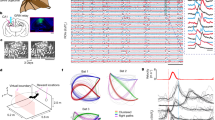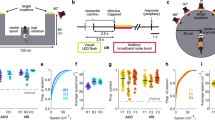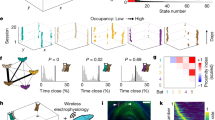Abstract
The hippocampus is crucial for episodic and spatial memory. In freely moving rodents, hippocampal pyramidal neurons show spatially selective firing when the animal passes through a neuron's 'place-field', and theta-band oscillation is continuously present during locomotion. Here we report the first hippocampal recordings from echolocating bats, mammals phylogenetically distant from rodents, which showed place cells very similar to those of rodents. High-frequency 'ripple' oscillations were also rodent-like. Theta oscillation, however, differed from rodents in two important ways: (i) theta occurred when bats explored the environment without locomoting, using distal sensing through echolocation, and (ii) theta was not continuous, but occurred in short intermittent bouts. The intermittence of theta suggests that models of hippocampal function that rely on continuous theta may not apply to bats. Our data support the hypothesis that theta oscillation in the mammalian hippocampus is involved in sequence learning and hence, theta power should increase with sensory-input rate—which explains why theta power correlates with running speed in rodents and with echolocation call rate in bats.
This is a preview of subscription content, access via your institution
Access options
Subscribe to this journal
Receive 12 print issues and online access
$209.00 per year
only $17.42 per issue
Buy this article
- Purchase on Springer Link
- Instant access to full article PDF
Prices may be subject to local taxes which are calculated during checkout






Similar content being viewed by others
References
O'Keefe, J. & Nadel, L. The Hippocampus as a Cognitive Map (Oxford University Press, Oxford, 1978).
Muller, R.U., Kubie, J.L. & Ranck, J.B., Jr . Spatial firing patterns of hippocampal complex-spike cells in a fixed environment. J. Neurosci. 7, 1935–1950 (1987).
Wilson, M.A. & McNaughton, B.L. Dynamics of the hippocampal ensemble code for space. Science 261, 1055–1058 (1993).
Buzsáki, G., Horváth, Z., Urioste, R., Hetke, J. & Wise, K. High-frequency network oscillation in the hippocampus. Science 256, 1025–1027 (1992).
Csicsvari, J., Hirase, H., Czurkó, A., Mamiya, A. & Buzsáki, G. Oscillatory coupling of hippocampal pyramidal cells and interneurons in the behaving rat. J. Neurosci. 19, 274–287 (1999).
Buzsáki, G. et al. Hippocampal network patterns of activity in the mouse. Neuroscience 116, 201–211 (2003).
Siapas, A.G. & Wilson, M.A. Coordinated interactions between hippocampal ripples and cortical spindles during slow-wave sleep. Neuron 21, 1123–1128 (1998).
Kudrimoti, H.S., Barnes, C.A. & McNaughton, B.L. Reactivation of hippocampal cell assemblies: effects of behavioral state, experience, and EEG dynamics. J. Neurosci. 19, 4090–4101 (1999).
Sirota, A., Csicsvari, J., Buhl, D. & Buzsáki, G. Communication between neocortex and hippocampus during sleep in rodents. Proc. Natl. Acad. Sci. USA 100, 2065–2069 (2003).
Vanderwolf, C.H. Hippocampal electrical activity and voluntary movement in the rat. Electroencephalogr. Clin. Neurophysiol. 26, 407–418 (1969).
Buzsáki, G. Theta oscillations in the hippocampus. Neuron 33, 325–340 (2002).
Lengyel, M., Huhn, Z. & Érdi, P. Computational theories on the function of theta oscillations. Biol. Cybern. 92, 393–408 (2005).
Ono, T., Nakamura, K., Nishijo, H. & Eifuku, S. Monkey hippocampal neurons related to spatial and nonspatial functions. J. Neurophysiol. 70, 1516–1529 (1993).
Ludvig, N., Tang, H.M., Gohil, B.C. & Botero, J.M. Detecting location-specific neuronal firing rate increases in the hippocampus of freely-moving monkeys. Brain Res. 1014, 97–109 (2004).
Georges-François, P., Rolls, E.T. & Robertson, R.G. Spatial view cells in the primate hippocampus: allocentric view not head direction or eye position or place. Cereb. Cortex 9, 197–212 (1999).
Ekstrom, A.D. et al. Cellular networks underlying human spatial navigation. Nature 425, 184–188 (2003).
Bragin, A., Engel, J., Jr., Wilson, C.L., Fried, I. & Buzsáki, G. High-frequency oscillations in human brain. Hippocampus 9, 137–142 (1999).
Robinson, T.E. Hippocampal rhythmic slow activity (RSA; theta): a critical analysis of selected studies and discussion of possible species-differences. Brain Res. 203, 69–101 (1980).
Siegel, J.J., Nitz, D. & Bingman, V.P. Hippocampal theta rhythm in awake, freely moving homing pigeons. Hippocampus 10, 627–631 (2000).
Stewart, M. & Fox, S.E. Hippocampal theta activity in monkeys. Brain Res. 538, 59–63 (1991).
Ekstrom, A.D. et al. Human hippocampal theta activity during virtual navigation. Hippocampus 15, 881–889 (2005).
Cantero, J.L. et al. Sleep-dependent theta oscillations in the human hippocampus and neocortex. J. Neurosci. 23, 10897–10903 (2003).
Bódizs, R. et al. Rhythmic hippocampal slow oscillation characterizes REM sleep in humans. Hippocampus 11, 747–753 (2001).
Amaral, D.G. & Lavenex, P. Hippocampal neuroanatomy. in The Hippocampus Book (eds. Andersen, P., Morris, R.G., Amaral, D.G., Bliss, T.V. & O'Keefe, J.) 37–114 (Oxford University Press, New York, 2007).
Springer, M.S., Stanhope, M.J., Madsen, O. & de Jong, W.W. Molecules consolidate the placental mammal tree. Trends Ecol. Evol. 19, 430–438 (2004).
Griffin, D.R. Listening in the Dark (Yale University Press, New Haven, 1958).
Schnitzler, H.-U., Moss, C.F. & Denzinger, A. From spatial orientation to food acquisition in echolocating bats. Trends Ecol. Evol. 18, 386–394 (2003).
Griffin, D.R. Migration and homing of bats. in Biology of Bats Vol. 1 (ed. Wimsatt, W.A.) 233–264 (Academic Press, New York, 1970).
Williams, T.C. & Williams, J.M. Radio tracking of homing and feeding flights of a neotropical bat, Phyllostomus hastatus. Anim. Behav. 18, 302–309 (1970).
McCracken, G.F. Locational memory and female-pup reunions in Mexican free-tailed bat maternity colonies. Anim. Behav. 45, 811–813 (1993).
Mueller, H.C. & Mueller, N.S. Sensory basis for spatial memory in bats. J. Mamm. 60, 198–201 (1979).
Surlykke, A. & Moss, C.F. Echolocation behavior of big brown bats, Eptesicus fuscus, in the field and the laboratory. J. Acoust. Soc. Am. 108, 2419–2429 (2000).
Thompson, L.T. & Best, P.J. Place cells and silent cells in the hippocampus of freely-behaving rats. J. Neurosci. 9, 2382–2390 (1989).
Skaggs, W.E., McNaughton, B.L., Wilson, M.A. & Barnes, C.A. Theta phase precession in hippocampal neuronal populations and the compression of temporal sequences. Hippocampus 6, 149–172 (1996).
Fyhn, M., Molden, S., Witter, M.P., Moser, E.I. & Moser, M.-B. Spatial representation in the entorhinal cortex. Science 305, 1258–1264 (2004).
Jung, M.W., Wiener, S.I. & McNaughton, B.L. Comparison of spatial firing characteristics of units in dorsal and ventral hippocampus of the rat. J. Neurosci. 14, 7347–7356 (1994).
Maurer, A.P., VanRhoads, S.R., Sutherland, G.R., Lipa, P. & McNaughton, B.L. Self-motion and the origin of differential spatial scaling along the septo-temporal axis of the hippocampus. Hippocampus 15, 841–852 (2005).
Winson, J. Interspecies differences in the occurrence of theta. Behav. Biol. 7, 479–487 (1972).
O'Keefe, J. & Recce, M.L. Phase relationship between hippocampal place units and the EEG theta rhythm. Hippocampus 3, 317–330 (1993).
Hasselmo, M.E., Bodelón, C. & Wyble, B.P. A proposed function for hippocampal theta rhythm: separate phases of encoding and retrieval enhance reversal of prior learning. Neural Comput. 14, 793–817 (2002).
Harris, K.D. et al. Spike train dynamics predicts theta-related phase precession in hippocampal pyramidal cells. Nature 417, 738–741 (2002).
Bland, B.H. & Oddie, S.D. Theta band oscillation and synchrony in the hippocampal formation and associated structures: the case for its role in sensorimotor integration. Behav. Brain Res. 127, 119–136 (2001).
Jensen, O. & Lisman, J.E. Hippocampal sequence-encoding driven by a cortical multi-item working memory buffer. Trends Neurosci. 28, 67–72 (2005).
Wallenstein, G.V. & Hasselmo, M.E. GABAergic modulation of hippocampal population activity: sequence learning, place field development, and the phase precession effect. J. Neurophysiol. 78, 393–408 (1997).
Ringo, J.L., Sobotka, S., Diltz, M.D. & Bunce, C.M. Eye movements modulate activity in hippocampal, parahippocampal and inferotemporal neurons. J. Neurophysiol. 71, 1285–1288 (1994).
Macrides, F., Eichenbaum, H.B. & Forbes, W.B. Temporal relationship between sniffing and the limbic theta rhythm during odor discrimination reversal learning. J. Neurosci. 2, 1705–1717 (1982).
Suzuki, W.A. & Clayton, N.S. The hippocampus and memory: a comparative and ethological perspective. Curr. Opin. Neurobiol. 10, 768–773 (2000).
Simmons, J.A., Moss, C.F. & Ferragamo, M. Convergence of temporal and spectral information into acoustic images of complex sonar targets perceived by the echolocating bat, Eptesicus fuscus. J. Comp. Physiol. [A] 166, 449–470 (1990).
Ellins, S.R. & Masterton, F.A. Brightness discrimination thresholds in the bat, Eptesicus fuscus. Brain Behav. Evol. 9, 248–263 (1974).
Skaggs, W.E., McNaughton, B.L., Wilson, M.A. & Markus, E.J. An information-theoretic approach to deciphering the hippocampal code. in Advances in Neural Information Processing Systems 5 (eds. Hanson, S.J., Cowan, J.D. & Giles, C.L.) 1030–1037 (Morgan Kaufman, San Mateo, 1993).
Acknowledgements
We thank K.D. Harris, M. Lengyel, A. Sirota, J. Siegel, S. Cowan, M. Aytekin, K. Ghose and J. Fritz for critically reading the manuscript, G. Sutherland and B. McNaughton for invaluable technical advice during N.U.'s visit to the Arizona Research Laboratories, J. Lisman, N. Kopell, A.D. Redish, W. Hodos, G. Wilkinson, K. Macleod, S. Sinha, C. Stengel, R. Harlan, T. Barnes and A. Graybiel for helpful discussions and technical advice, B. Falk for help with experiments, E. Covey for a preprint of the bat brain atlas, E. Sanovich for histology and C. Carr for use of the Neurolucida system. This research was supported by US National Institutes of Health grant R01 MH56366 to C.F.M. and by the Center for Neuroscience at the University of Maryland.
Author information
Authors and Affiliations
Contributions
N.U. designed the study, conducted the experiments, analyzed the data and wrote the manuscript. C.F.M. supervised the project.
Corresponding author
Ethics declarations
Competing interests
The authors declare no competing financial interests.
Supplementary information
Supplementary Fig. 1
Spatial maps (spatial distributions) of the two behavioral modes. (PDF 36 kb)
Supplementary Fig. 2
Histograms of theta-to-delta ratio. (PDF 24 kb)
Supplementary Fig. 3
Depth profile of the percentage of time occupied by theta bouts. (PDF 14 kb)
Supplementary Fig. 4
Average firing rates of individual recorded cells. (PDF 16 kb)
Rights and permissions
About this article
Cite this article
Ulanovsky, N., Moss, C. Hippocampal cellular and network activity in freely moving echolocating bats. Nat Neurosci 10, 224–233 (2007). https://doi.org/10.1038/nn1829
Received:
Accepted:
Published:
Issue Date:
DOI: https://doi.org/10.1038/nn1829
This article is cited by
-
A perspective on neuroethology: what the past teaches us about the future of neuroethology
Journal of Comparative Physiology A (2024)
-
A realistic computational model for the formation of a Place Cell
Scientific Reports (2023)
-
Contextual and pure time coding for self and other in the hippocampus
Nature Neuroscience (2023)
-
Dynamic synchronization between hippocampal representations and stepping
Nature (2023)
-
The sky compass network in the brain of the desert locust
Journal of Comparative Physiology A (2023)



